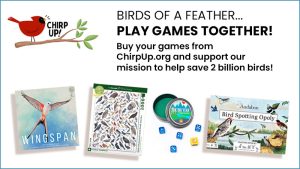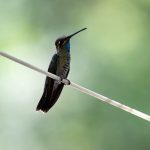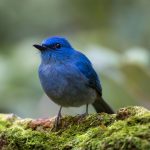When I worked for a wild bird specialty store, I was always baffled by the question from customers in spring, “When do I take my feeders down?”
Most people are under the impression that birds “need” bird feeders only in winter and will not eat “natural” foods in summer if feeders are still up and become too dependent. I don’t want to hurt your feelings, but no matter how awesome and expensive your bird feed is, it simply cannot compete with the abundance of insect life that bursts forth in warmer months. Most bird species cannot live by black oil sunflower seed alone.
The other thing that baffled me is that birds are the most colorful in the summer–all that crazy breeding plumage. How could you not want to attract that to your yard? I defy someone to look out the window and see a neon orange Baltimore Oriole accented by bright American Goldfinches and not acknowledge how cool that is.
Plus migration brings a whole lotta fun with birds like the above Rose-breasted Grosbeak or Indigo Buntings at seed feeders and if you offer fruit you can even get the occasional tanager.
As summer progresses, you get to watch adult birds bring their young to feeders and teach them how to use the feeders. One of my all time favorite bird feeding moments involved a Blue Jay family. One particular bird wouldn’t stop begging towards an adult, it was very insistent. The adult appeared to be making somewhat slower and more exaggerated movements on a suet feeder as if to communicate, “Watch me eat! This is what you do. Now, knock of the whining, kiddo.”
After the adult had it’s fill, the younger jay stayed behind and then went up to the suet feeder itself and begged at the feeder. Needless to say, an inanimate log is not going to stuff globs of no melt suet into the jay’s gullet. The bird begged and begged and then as if it were frustrated, it pecked the log like it would a sibling in its way in the nest. It’s beak happened to land where there was some suet. The young Blue Jay tasted it and I swear, you could see the light bulb go off in its head and it attacked the suet with gusto, I mean, that bird chowed down. As it was doing so, I could hear soft little sounds coming from it as if to say, “Yeah, man, I am so clever, I figured this out, I am eating and so happy.”
But there are legitimate times to take down your feeder. For example, if you see birds that are showing signs of illness like house finches with swollen eyes or a goldfinch perched for long periods at a feeder that is not eating and perhaps even sleeps. Take your feeders down and disinfect them with a mild solution of bleach and water. Keep them down for at least 10 days so the sick birds will die off (hawks have to eat something) and others that might be infected will move on. It seems cruel and for most people the inclination is to keep the feeder up to help the sick, but it prolongs illness and infects more birds.
Another time to consider taking your feeders down for a limited time is if you get a blackbird takeover when their young leave the nest. Those sorts of flocks can drain a feeder in no time. You can try switching all your feeders to plain safflower but a drastic food change like that can cause a huge dip in all bird activity for 2-3 weeks (even tho tons of birds eats safflower). Birds typically do not like change so a big switch in food can keep some away. Once they get used it, they will chow down on safflower but the few weeks to get everybody on board with it is about how long a blackbird flock will stay, so it maybe easier to keep the feeders empty until the blackbirds flock up and move on.
But for the most part, feeding birds in summer is Technicolor fun and worth doing.
















Up around these parts (Northern Ontario) the provincial Ministry of Natural Resources advises people not to put up feeders in summer so as not to attract bears. Not a real problem where I am, so I ignore that. Though some birders I know who see bears more often have grown weary of the bears destroying their feeders.
In fall, I’m happy to endulge the Redwings and Grackles for it’s then, and only then, that I get to see a few Rusties.
I have never left my feeders up for the summer but I do leave them up for the spring migration. I love the variety of birds at my feeders. I am considering putting them up again for the summer after reading your post. Bird baths are another plus for attracting birds to your yard. Especially when we have dry spells.
Hi, Thanks for the article. I was wondering if you have read studies suggesting that supplemental feeding can lead to reduced clutch size and delayed morning singing in males? Thoughts on this? Thanks, Laura
http://news.discovery.com/animals/bird-feeders-breeding-110125.htm
But then there are studies that suggests supplemental feeding leads to at least one extra chick reaching maturity:
http://www.nature.com/news/2008/080205/full/news.2008.557.html
I have to Stop feeding, because I get tons of Starlings and Blackbirds in Mid March here in Virginia. I have a Certified Wildlife Habitat, and my Eastern Bluebirds and Tree Swallows arrive by March. – or April. When my Nesting Birds start checking out the Nesting Boxes, I stop feeding. Starlings and Blackbirds, also Bluejays are not good to have around the Nesting Birds. I planted many Native flowers, Plants, Berry-producing Wildlife Bushes, Milkweed and many others for Birds, Bees, Monarch Butterflies, Swallowtails etc. Tree Swallows feed and drink in the Air, Tree Swallows and Eastern Bluebirds do not eat Bird seeds. These lovely Birds feed on Insects. The Bluebirds do like Live Meal Worms, so does the Robins. I also have some Cardinals, Chickadees, Nuthatches, Woodpeckers, Titmouse. In the late Spring I will have Cat Birds, Orioles. I have several Red Hot Poker Plants, which the Orioles munch on the Berries. My Cat Birds and the Eastern Bluebirds will eat my Elderberries. Last Summer I had the Absolute Joy to Witness 40 young Tree Swallows and 5 young Eastern Bluebirds fledged Successfully out of my Nesting Boxes. This year I just saw and heard my first Tree Swallows arrive on March 18. I could hardly believe my eyes and ears to see and hear my lovely little Beauties high up in the Blue Sky, and around my Backyard checking out Nesting Boxes.